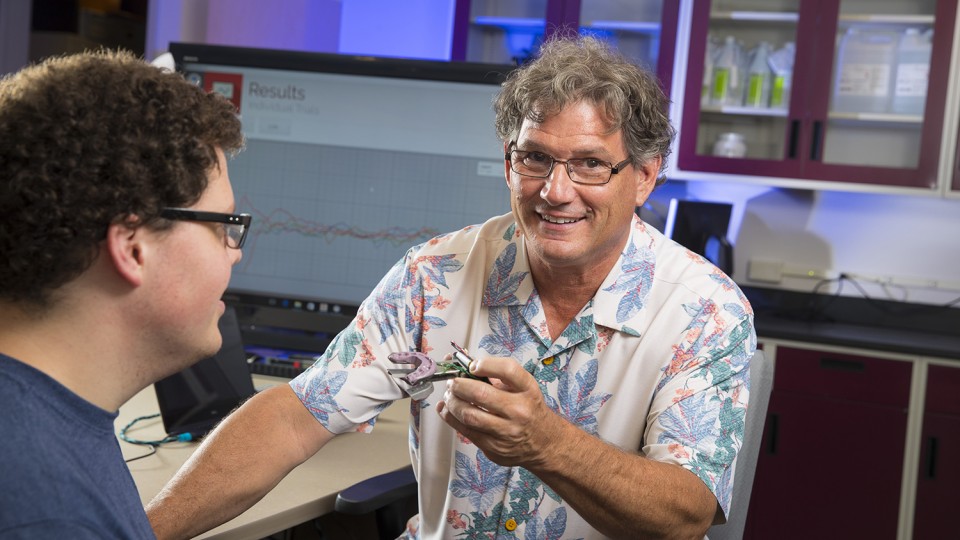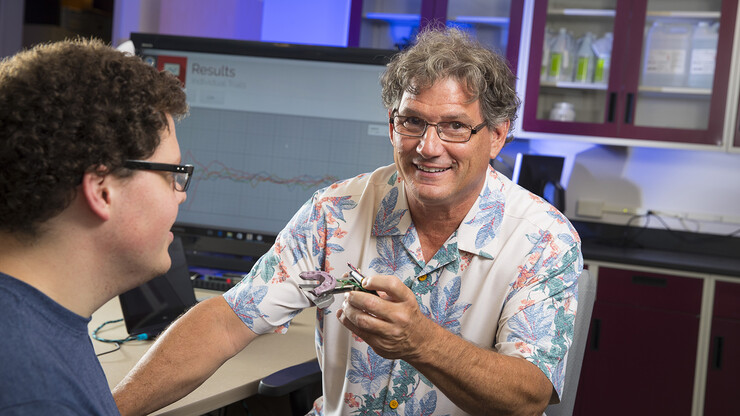· 6 min read
System could help diagnose, treat brain injuries

Steven Barlow is using just a bit of brawn to assess the brain.
The University of Nebraska researcher has developed a novel system that measures muscle forces in the face, mouth and fingers to help evaluate the health of the staggeringly complex but fragile organ that controls them.
With a prototype soon to be piloted at Lincoln’s Madonna Rehabilitation Hospital, the system could inform the diagnosis and treatment of nervous system conditions ranging from stroke and traumatic brain injury to Parkinson’s disease and autism.
“This system provides a non-invasive method for systematically assessing how much function remains in these motor systems following insult to the brain,” said Barlow, the Corwin Moore Professor of special education and communication disorders. “It gives clinicians, really for the first time, a set of objective measurements that they can use not only for diagnostics but … as a therapeutic feedback device.”
Known as ForceWIN10, a nod to its function and operating system, the technology features custom software and pressure-sensitive instruments that collectively cost only a few hundred dollars. In a matter of minutes, the system can wirelessly measure and record how much force is generated – and how well that force is controlled – by muscles essential to the fine motor control required for everyday tasks.
“You have parts of your spinal cord that drive your … control over individual digits or wrist flexors,” Barlow said. “Then you get into the brain stem, which is involved in the motor control of all muscles in the face. This provides a diagnostic window into the nervous system’s health, segment by segment.”
Real-time feedback from the ForceWIN10 system reads out on a screen visible to both patient and physician, with the system’s sensors embedded in various instruments designed to detect even the slightest muscle forces.
One instrument, resembling a double-sided mouthguard, records the bite forces generated by various jaw muscles. Another, shaped somewhat like a miniature saddle, can measure twitches of the upper and lower lip. The tongue gets it due in the form of a cantilever-style instrument that can gauge compression forces toward the roof of the mouth. And the system quantifies finger contractions via a device about the size and shape of a few stacked poker chips, with a pea-sized pressure sensor at its center.
For a patient, interacting with ForceWIN10 can look and feel akin to playing a rudimentary video game that nevertheless presents “a major challenge,” Barlow said. Computer-generated lines and shapes, sometimes shifting on a second-to-second basis, prompt a patient to match on-screen benchmarks by using facial muscles or fingers to produce a corresponding level of force.
“Instead of dragging a mouse and moving a cursor, you get the cursor to move on the screen by squeezing with the appropriate structure,” Barlow said. “It’s a real trick. It’s pretty difficult even for the neurotypical brain, and that’s good. We don’t want it to be easy. If it’s too easy, it’s worthless.”
The full battery of assessments will allow physicians to measure more than a dozen force-related variables. How fast do the muscles contract and relax? How accurately is a patient mimicking on-screen prompts? How long does it take for muscles to fatigue? Running statistical analyses of the data, Barlow said, enables the system to answer these questions and many more.
Barlow, who also is associate director of the university’s Center for Brain, Biology and Behavior, envisions ForceWIN10 being used to establish a baseline of muscle force performance soon after a brain injury or the initial symptoms of a neurodegenerative condition. Comparing that baseline with assessments taken in subsequent days, weeks or even months could give physicians the information they need to better evaluate recoveries and tailor treatment programs accordingly, he said.
“They can do daily therapy using this technology to help patients restore function, whether it’s trouble eating, speaking, writing or using their fingers to operate a phone or keyboard,” Barlow said. “That’s kind of the big picture.
“(With) these clinical problems, there’s such a gap between bench and bedside. There are entire scientific communities that are thriving at the bench but totally unaware of the applications in the clinic. So this was a great opportunity to bridge that gap.”
NUtech in progress
The project also became an opportunity to bridge the ever-narrowing gap between faculty and undergraduate research. Two years ago, a manager from the university’s technology development affiliate, NUtech Ventures, contacted Barlow to learn more about the recently hired researcher’s work. After Barlow explained ForceWIN10, NUtech put him in touch with Ian Cottingham, director of the design studio at the Jeffrey S. Raikes School of Computer Science and Management.
Cottingham and several of his students visited Barlow’s lab, where he gave them a crash course in the science of muscle forces and the system he was designing to measure them. Barlow also gave the students access to the system’s source code, which was then running on the Windows XP operating system.
“As a faculty mentor, the idea is to not dictate but rather say, ‘Here are some challenges. Let’s see if we can get rid of all these wires. Let’s get it on (Windows) 10. Come up with a really powerful relational-type database. Please improve on our rudimentary graphic user interface and come up with something that is really nice – something that’s going to be patient-friendly.’ We wanted them to use their imaginations.”
The Raikes School students did exactly that, Barlow said, while migrating the software to Windows 10, integrating Bluetooth-enabled sensors and helping construct multiple prototypes of the system. The fact that the Raikes team encompassed multiple disciplines – mechanical and materials engineering, electrical and computer engineering, computer science – helped it enhance the system in ways that Barlow said even he could not have anticipated.
“These students each brought such unique talents and skills,” Barlow said. “So it was fun watching them just take off. They were doing things I had no clue how they managed to do.”
Barlow has since filed for a patent through NUtech Ventures, which he and Cottingham credited with spurring a symbiotic collaboration.
“NUtech Ventures really is a catalyst for innovation, and we are very fortunate to have the opportunity to participate in this kind of technology transfer project,” Cottingham said. “This is what innovation is all about: partnerships, teamwork and making a product that makes a difference.”








